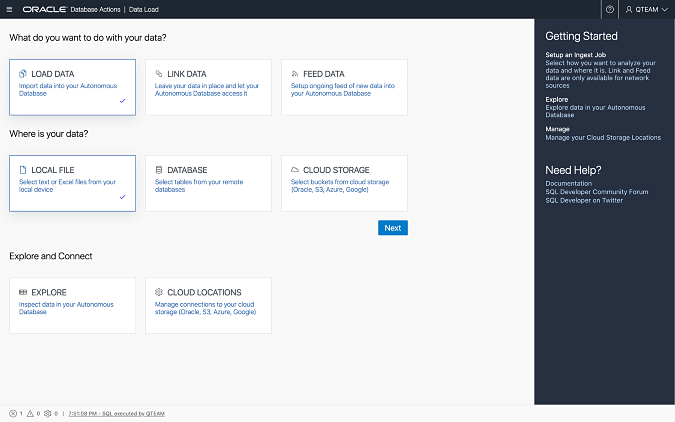
- Provides easy-to-use, no-code tools that empower Data Analysts to do tasks that previously required data engineers and data scientists
- Puts faster, more powerful insights within the reach of organizations of all sizes
March 25, 2021
Today Oracle announced a set of innovative enhancements to Oracle Autonomous Data Warehouse, the industry’s first and only self-driving cloud data warehouse. With this latest release, Oracle goes beyond other cloud offerings by completely transforming cloud data warehousing from a complex ecosystem of products, tools, and tasks that requires extensive technical expertise, time and money to perform data loading, data transformation and cleansing, business modeling, and machine learning into an intuitive point-and-click, drag-and-drop experience for data analysts, citizen data scientists, and business users. As a result, Oracle Autonomous Data Warehouse empowers organizations of all sizes—from the smallest to the largest—to get significantly more value from their data, achieve faster results, accelerate insights, and improve productivity while lowering costs with zero administration.
The latest enhancements to Oracle Autonomous Data Warehouse provide a single data platform built for businesses to ingest, transform, store, and govern all data to run diverse analytical workloads from any source, including departmental systems, enterprise data warehouses and data lakes.
“Oracle Autonomous Data Warehouse is the only fully self-driving cloud data warehouse today,” said Andrew Mendelsohn, executive vice president, database server technologies, Oracle. “With this next generation of Autonomous Data Warehouse, we provide a set of easy-to-use, no-code tools that uniquely empower business analysts to be citizen data scientists, data engineers, and developers.”
Citizen data scientists and analysts will also benefit from powerful new self-service graph modeling and graph analytics. To empower developers to build data-driven applications, Oracle offers Oracle APEX (Application Express) Application Development, a low-code application development tool built directly into its cloud data warehouse, as well as RESTful services, which makes it easy for any modern application to interact with warehouse data. Unlike other vendors’ single-purpose, isolated databases in the cloud, Oracle Autonomous Data Warehouse provides support for multi-model, multi-workload, and multi-tenant requirements—all within a single, modern converged database engine—including JSON document, operational, analytic, graph, ML, and blockchain databases and services.
New Innovations in Oracle Autonomous Data Warehouse
The latest release includes many new innovations, not only a broad set of capabilities that make it easier for analysts, citizen data scientists, and line-of-business developers to take advantage of the industry’s first and only self-driving cloud data warehouse, but also features that deliver deeper analytics and tighter data lake integration. Key capabilities include:
- Built-in Data Tools:Business analysts now have a simple, self-service environment for loading data and making it available to their extended team for collaboration. They can load and transform data from their laptop or the cloud by simply dragging and dropping. They can then automatically generate business models; quickly discover anomalies, outliers and hidden patterns in their data; and understand data dependencies and the impact of changes.
- Oracle Machine Learning AutoML UI:By automating time-intensive steps in the creation of machine learning models, the AutoML UI provides a no-code user interface for automated machine learning to increase data scientist productivity, improve model quality and enable even non-experts to leverage machine learning.
- Oracle Machine Learning for Python:Data scientists and other Python users can now use Python to apply machine learning on their data warehouse data, fully leveraging the high-performance, parallel capabilities and 30+ native machine learning algorithms of Oracle Autonomous Data Warehouse.
- Oracle Machine Learning Services:DevOps and data science teams can deploy and manage native in-database models and ONNX-format classification and regression models outside Oracle Autonomous Data Warehouse, and can also invoke cognitive text analytics. Application developers have easy-to-integrate REST endpoints for all functionality.
- Property Graph Support:Graphs help to model and analyze relationships between entities (for example, a social network graph). Users can now create graphs within their data warehouse, query graphs using PGQL (property graph query language) and analyze graphs with over 60 in-memory graph analytics algorithms.
- Graph Studio UI:Graph Studio builds on property graph capabilities of Oracle Autonomous Data Warehouse to make graph analytics easier for beginners. It includes automated creation of graph models, notebooks, integrated visualization and pre-built workflows for different use cases.
- Seamless Access to Data Lakes:Oracle Autonomous Data Warehouse extends its ability to query data in Oracle Cloud Infrastructure (OCI) Object Storage and all popular cloud object stores with three new data lake capabilities: easy querying of data in Oracle Big Data Service (Hadoop); integration with OCI Data Catalog to simplify and automate data discovery in object storage; and scale-out processing to accelerate queries of large data sets in object storage.


